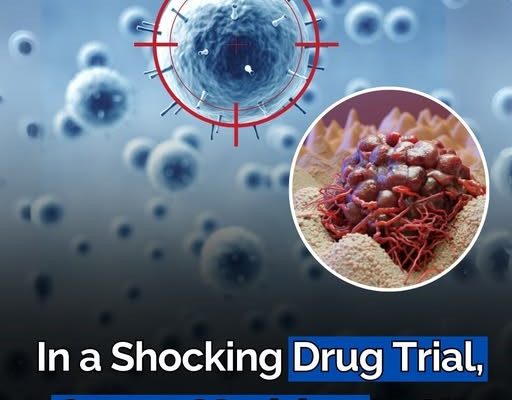In a stunning development from Manhattan’s Memorial Sloan Kettering Cancer Center, a new drug trial has achieved what many in the medical community are calling a medical marvel: complete remission of cancer in every participant. This small, yet unprecedented trial has sparked a wave of optimism and curiosity across the globe, as the drug, dostarlimab, shows potential to redefine cancer treatment standards. What does this mean for the future of oncology and for patients facing this devastating disease?
The Trial at a Glance
In an extraordinary turn of events, a drug trial conducted at the esteemed Memorial Sloan Kettering Cancer Center has set the medical world abuzz. The trial focused on dostarlimab, an innovative checkpoint inhibitor, and involved a select group of rectal cancer patients. Remarkably, every single participant achieved complete remission—a rare phenomenon in the realm of oncology.
The study was small but meticulously planned, involving just 12 patients diagnosed with locally advanced rectal cancer. These patients were chosen based on specific criteria likely to respond to the new treatment, considering the severity and location of their cancer.
Dostarlimab was administered every three weeks over a six-month period. This regimen was designed to test the drug’s efficacy in unmasking cancer cells to the body’s immune system, allowing for their identification and subsequent destruction.
The effectiveness of the treatment was rigorously evaluated using a combination of physical exams, endoscopies, positron emission tomography (PET) scans, and magnetic resonance imaging (MRI). The unanimous result—complete disappearance of the tumors—was both shocking and exhilarating for the medical team and the oncology community at large.
Patient Experiences

Before participating in the trial, many of the patients had undergone extensive and exhausting treatments, including chemotherapy and radiation, which not only failed to eliminate their cancer but also compounded their suffering with severe side effects. “The patients had almost given up hopes after failing to recover after going through grueling chemotherapy and radiation sessions,” noted Dr. Andrea Cercek, an oncologist at Memorial Sloan Kettering and co-author of the study. Some were even facing the prospect of “life-altering” surgeries that could result in permanent changes to their bodily functions.
The administration of dostarlimab, however, marked a turning point. To their astonishment, patients were informed that their tumors had vanished, and no further invasive treatments were necessary. Dr. Cercek recalled the moment of revelation, describing it as a time of “a lot of happy tears.” The emotional impact of this news cannot be understated, as it not only signified a physical reprieve but also a monumental shift in their mental and emotional outlook.
Patients were closely monitored for signs of recurrence through regular follow-ups involving advanced imaging techniques. Astonishingly, there were no signs of the cancer returning up to 25 months after the trial’s conclusion. This sustained remission brought a profound sense of relief and a cautiously optimistic outlook towards the future.
One patient, reflecting on their experience, expressed immense gratitude: “Not expecting their cancerous tumors to subside, they agreed to be part of the dostarlimab trial. But to their pleasant surprise, they were taken off the painful chemotherapy and radiation sessions and also told that there would be no need to go under the knife.”
How Dostarlimab Works
Dostarlimab represents a significant advancement in the field of oncology, specifically within the realm of immunotherapy. As a checkpoint inhibitor, its mechanism targets the immune system’s ability to recognize and destroy cancer cells, a process typically hindered by the cancer cells themselves.
Cancer cells have the cunning ability to hide from the immune system by exploiting certain proteins that act as checkpoints. These checkpoints are normally used by the body to prevent the immune system from attacking its own cells. However, dostarlimab works by blocking these checkpoint proteins, thereby removing the “invisibility cloak” that cancer cells use to shield themselves from immune attack. This action allows T-cells, the body’s natural defense killers, to see and destroy the cancer cells.
Checkpoint inhibitors like dostarlimab are part of a broader category of drugs that have revolutionized cancer treatment in recent years. They are particularly effective against cancers that have a high mutation burden, which makes them more visible to the immune system once the checkpoints are inhibited. Dostarlimab specifically targets the PD-1/PD-L1 pathway, a crucial player in the immune evasion strategy of many tumors.
In the trial at Memorial Sloan Kettering, dostarlimab was administered every three weeks for six months, a regimen that proved to be remarkably effective without the severe side effects often associated with conventional cancer treatments like chemotherapy. “Such drugs, known as ‘checkpoint inhibitors’, usually have some kind of adverse reaction in 20% of patients who undergo the treatments. Nearly 60% of patients have severe complications, including muscle weakness. But no negative reaction was seen in the patients involved in the dostarlimab study,” highlighted the study’s report.
This favorable safety profile, combined with the drug’s efficacy in inducing a complete response in trial participants, underscores the potential of dostarlimab not only as a treatment for rectal cancer but possibly for other cancers that share similar biological markers.
Unprecedented Results

Traditionally, the mainstay of cancer treatment has involved a combination of surgery, chemotherapy, and radiation therapy. These methods, while effective for many, often come with debilitating side effects and a significant impact on the patient’s quality of life. The complete remission of cancer in all trial participants with dostarlimab suggests a potential shift towards less invasive treatment options. This could mean fewer surgeries and a reduced reliance on the harsher aspects of chemotherapy and radiation, particularly for cancers amenable to immunotherapy.
The trial underscores the importance of personalized medicine in cancer treatment. By targeting specific genetic markers and pathways, treatments like dostarlimab can be tailored to individual patients, increasing the efficacy and reducing unwanted side effects. This approach is particularly promising for cancers that have historically been difficult to treat with conventional methods. As genetic testing and biomarker research advance, personalized immunotherapies could become the norm rather than the exception.
The results of this trial are likely to inspire further research into checkpoint inhibitors and other forms of immunotherapy. Given the dramatic outcomes seen in this study, additional trials are expected to explore the application of dostarlimab across a broader range of cancers and stages. This could potentially expand the benefits of this therapy to a wider patient population, including those with cancers that do not currently have effective treatment options.
Beyond the scientific community, the implications of this trial extend to global health policy and the economics of healthcare. If treatments like dostarlimab can provide a cure or long-term remission with fewer resources and less patient trauma, they could alleviate the substantial financial and logistical burdens associated with traditional cancer treatments. However, the high cost of such drugs remains a significant barrier, emphasizing the need for policy interventions that ensure access to these life-saving therapies across all segments of the population.
Economic and Accessibility Considerations
While the clinical success of dostarlimab introduces a hopeful chapter in cancer treatment, it also brings to light significant economic and accessibility considerations that must be addressed to ensure that this innovative therapy can benefit a broad spectrum of patients globally.
Cost of Treatment: Dostarlimab’s trial phase has revealed a high cost of $11,000 per dose, presenting a substantial barrier to widespread use, especially in lower-income countries and even for middle-class families in developed nations. If approved for wider clinical use, the financial implications could limit accessibility for many who need it most unless measures are taken to manage these costs.
Insurance and Healthcare Policies: For dostarlimab to be accessible, insurance companies and healthcare systems will need to evaluate how such treatments are covered. Changes in policy could include increased funding for cancer treatment drugs or adjustments in the way high-cost therapies are subsidized by public health systems. Furthermore, healthcare policies must adapt to cover new and emerging treatments without placing undue financial strain on patients.
Manufacturing and Distribution: Scaling up the production and distribution of a new drug like dostarlimab poses its own challenges. Pharmaceutical companies, governments, and international health organizations will need to collaborate to ensure that these drugs can be manufactured at a scale that meets global demand and distributed in a way that reaches all patients in need, regardless of geography.
Research and Development Costs: The development of innovative drugs like dostarlimab involves substantial investment in research and development (R&D), which typically drives up the cost. However, investment in further research could also lead to more cost-effective production methods or alternative drugs that can perform similarly at a lower cost.
Ethical Considerations: There is also an ethical imperative to consider how new treatments are allocated globally. The principle of equity in healthcare argues for the need to ensure that all patients who could benefit from dostarlimab have the opportunity to do so, not just those in affluent countries or well-funded healthcare systems.
Long-Term Sustainability: Finally, the long-term sustainability of financing high-cost treatments like dostarlimab must be considered. This includes examining the overall impact on healthcare budgets and exploring innovative financing models that could support their inclusion in standard treatment regimens without compromising other areas of healthcare.
A New Dawn in Cancer Care
The successful outcomes of the dostarlimab trial at Memorial Sloan Kettering Cancer Center represent more than just a medical breakthrough; they signal a potential sea change in how we approach and treat cancer. This trial has not only demonstrated unprecedented success in eradicating cancer in all participating patients but also highlighted the immense possibilities that modern science holds in transforming the lives of those afflicted with this formidable disease.
As we stand on the cusp of possibly revolutionizing cancer therapy, it is imperative that the medical community, policymakers, and society at large consider the broader implications of these findings. The introduction of dostarlimab into the market could pave the way for treatments that are more effective, less invasive, and more humane than ever before. However, for these innovative therapies to benefit everyone, concerted efforts are necessary to address the economic and accessibility challenges that could hinder widespread adoption.
Looking forward, it is crucial to continue supporting rigorous research to validate and expand upon these findings. Equally important is fostering a healthcare environment that promotes equitable access to these life-saving therapies, ensuring that all patients, regardless of their economic circumstances or geographic locations, can benefit from the latest advancements in medical science.
The promise shown by dostarlimab extends a beacon of hope—not just for those battling cancer today but for future generations who may face this disease. With continued dedication and collaboration across various sectors, we are moving towards a future where cancer may no longer be a death sentence but a manageable condition with viable treatment options.


